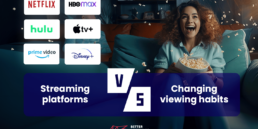The numbers speak for themselves: the popularity of SVoD services is on the rise. The trend is expected to continue into the 2020s, and the reasons are plenty: changing consumer habits, convenience and affordability. The switch to SVoD is inevitable and constitutes a natural step in the development of media consumption habits.
Streaming services like Netflix, Amazon Prime or HBO Go have not only redefined the TV-watching experience but also seriously impacted the media landscape and posed new challenges for broadcast media and production companies. It is estimated that over 13 million households now have at least one streaming subscription. What does this say about the future of television as a medium? In this article, we take a closer look at what the trend looks like across different countries in Europe.
UK market
Competition in the UK streaming market is gaining momentum with Apple TV+ launched in 2019, Britbox launch imminent and Disney+ and other media owners are gearing up to launch streaming services in the UK in 2020.
When it comes to SVoD in the UK, Netflix and Amazon Prime have reigned for years. But with Apple TV and BritBox newly launched and the Disney+ launch just around the corner, the battle for enticing content widens and with it the battle for our wallets. Just how many new SVoD services can the market take in terms of price sensitivity?
UK SVoD market in numbers
-
Over 46% of homes in the UK subscribe to Amazon, Netflix or Now TV streaming services.
- Over 13.3m households have a subscription SVoD service such as Netflix, Amazon Prime or Now TV.
- Netflix is the UK’s most popular streaming service, with 11.47 million subscribers.
-
On average, Britons watch over 19 hours of TV every week, not including streaming services.
Between Q4 2018 and Q1 2019 there were more than 1 million new SVoD subscriptions, the first time the number of new subscriptions has exceeded 1 million. No wonder new players want a piece of the cake. Today, only a handful of internet giants hold the streaming competition in check. According to the latest statistics from the British Association for Screen Entertainment (BASE), the home entertainment sector grew by 9.5% in 2019, bringing the total market value to £2.6 billion. Subscription video on demand (SVoD) accounted for 65.9% of this total, with Amazon and Netflix leading the charge in the UK.
France
France is one of the biggest SVoD markets in Europe – video entertainment consumer spend exceeded €7 billion in 2019. Netflix still leads the SVoD charge, but competition is slowly but steadily chipping away at the golden goose. For example, the leading French OTT streaming platform Molotov, although launched only in 2016, has already announced hitting the major milestone of 10 million users.
But there is still space for growth. A recent Futuresource’s report indicates that SVoD is still relatively uncommon in France, with less than 40 per cent of SVoD households taking more than one service. But this is associated with a completely new deal of problems. Having to subscribe to multiple platforms will increasingly lead to the so-called “subscription fatigue”, i.e. frustration with the increasingly fragmented programming choices and the impossibility to “own it all”. We’ve written about it more extensively in another post on the blog.
This creates an opportunity for a completely new type of services which, to make it easier for the viewers, aggregate the content across multiple platforms and provide a seamless experience. Among other things, this allows users to use a single platform to get recommendations and discover new content.
Global & US market
The numbers for individual markets may differ, but the general trend is clear: streaming services will be forced to fight for dominance in an increasingly competitive landscape. The war, however, is shifting to a completely different battlefield – since it is getting more and more difficult to lure new subscribers with price alone, original content is becoming the key factor for streaming companies to distinguish and win over audiences. And Netflix is currently killing it, churning new shows at an incredible pace. Original shows on the platform make up 40% of all content. By comparison, Hulu’s original shows make up just 10% of the entire content on the platform.
Netflix is expected to strike a 50/50 balance with its original content in 2020.
Netflix’s fantasy series The Witcher was a big hit in 2019, beating its competitors’ original content: Disney+’s The Mandalorian, Apple TV+’s The Morning Show and Amazon Prime Video’s Jack Ryan.
Among the goals of producing original programming is a promise to sell it off for syndication rights.
Streaming stacks gain popularity
A recent report found that 27 percent of the surveyed 1,000 US consumers spend, on average, $100 on their streaming platform subscriptions combined. At the same time, 59% of them say they’re happy with their subscriptions and just 22% say they would be ready to add another platform. This does not sound promising for the new players, but subscribers shouldn’t complain – after all, publishers are doing all they can to please them.
With more platforms to choose from, viewers will be bound to subscribe to several SVoD services as a way to create their customized “streaming stacks”. In Europe and the US, the proportion of people subscribing to three or more SVoD plans has been growing for the last several years.
Last words
The increasing popularity of streaming services is causing a major shift in the media landscape. However, in many countries, people still stick to the combination of SVoD and pay-TV as a convenient way to supplement satellite TV services with online video catalogues. But the proportion varies between markets. For example, in The Netherlands, South Africa and the US, where every second household mixes pay-TV and SVoD. By comparison Japan, favors free TV and SVoD combinations.
The cord-cutting trend, at the same time, is undeniable. In Western European markets and the US, the number of consumers using a combination of SVoD and free TV (rather than a commercial cable TV subscription) has been increasing for years. This is particularly evident in Italy and the UK.
But while cord-cutting has often been portrayed as a disruptive trend in the US, it has to be seen as more of an evolution, i.e. something that equally benefits the viewer and creates opportunities unheard of before.
If you find this article valuable, you can share it on social media →
Read more about the VOD & OTT Industry!
April 25, 2024
What is Connected TV and why is it becoming so popular?
Discover the benefits of Connected TV as it transforms entertainment by delivering internet-powered content through smart TVs and streaming devices.
March 7, 2024
7 reasons why is sports streaming becoming so popular
Learn more about the reasons why sports streaming is becoming more and more popular right now.
February 29, 2024
Why should streaming platforms adapt to changing viewing habits?
Discover the strategies through which streaming platforms adjust to changing viewing habits.
Are you looking for a partner to build a Video Solution?
Leave your email and a short description about your project. We would gladly discuss different cooperation possibilities!





